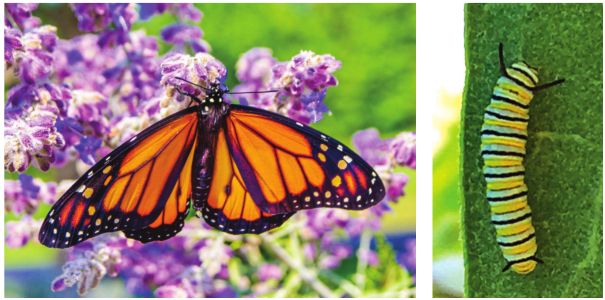
One of the first reported sightings of a monarch butterfly in the Springfield area was on May 9, according to the website Journey North. The first monarchs usually arrive in April and May.
Beginning in February, monarchs – which weigh no more than a paper clip – begin an amazing 3,000-mile journey northward from their overwintering sites in the oyamel fir forests of central Mexico, into Texas and up into Oklahoma, throughout the Midwest and into eastern Canada following the milkweed, which is native to the Midwest.
Along their migration route during the spring and summer breeding season, female monarchs lay their eggs on the leaves of the milkweed, which serves as the caterpillars’ only food source. Because of declining habitat and the widespread use of herbicides, the common milkweed is being decimated, threatening the survival of the species that depends on it.
Chip Taylor, founder and director of Monarch Watch, an outreach program based at the University of Kansas, estimates we are losing habitat at a rate of 6,000 acres a day – or 2.2 million acres a year, an area the size of Delaware and Rhode Island combined.
There has been a corresponding decline in monarch population numbers. During the past 20 years, the population has declined more than 90 percent, with the lowest numbers recorded in 2013-14. Once numbering in the billions, there are now fewer than 93 million monarchs.
The monarch population fluctuates.
This year Taylor sees an increase in population numbers. Because of the cold weather across most of the country early this year, the monarchs were able to stay and reproduce in Texas, so there was a bigger generation moving north out of the state. “They’re doing a great job moving north,” the former Springfield resident said.
In 2013-14, evidence of a major decline in monarch numbers set in motion measures to conserve the butterfly. In June 2019 the U.S. Fish and Wildlife Service will decide whether to list the monarch on the federal Endangered Species List.
“The monarch is the canary in the cornfield,” said Brenda Larison, University of Illinois Extension Master Naturalist volunteer for the University of Illinois Extension Logan-Menard-Sangamon Unit.
The population decline indicates a larger issue at work. “It tells us we’re not managing our landscape the way we should,” said Taylor.
The Illinois Department of Natural Resources is working with Midwest Association of Fish and Wildlife Agencies to develop a mid-America monarch strategy to increase the number of stems of new milkweed on the ground by 2025. Illinois is also preparing an Illinois Monarch Action Plan that will address conservation strategies that can be implemented to meet the habitat target.
In 2005, Monarch Watch created the Monarch Waystation program. This program encourages the public to create and register monarch waystations, or monarch habitats, to offset the loss of milkweeds and native plants that monarchs and other pollinators need. Adult monarchs rely on nectar sources for energy to sustain them during the migration back to their overwintering sites in Mexico in the fall.
In its first year, the program registered 500 to 600 waystations. Today the program adds close to 3,000 a year, and recently registered its 20,000th waystation. There are about 17 in the Springfield area.
In 2014, in partnership with the Illinois Historic Preservation Agency and the University of Illinois Extension, volunteers with the Master Gardener and Naturalist programs added the garden behind the cottage at the Dana-Thomas House State Historic Site.
The garden contains several types of milkweeds and pollinator plants native to this area and provides habitat and shelter for monarchs. It was designated a monarch waystation in 2015, and is maintained by the volunteers. The garden is also one of five designated pollinator pockets in the Springfield area by the University of Illinois Extension office.
A pollinator pocket is a great way to restore native habitat in urban spaces. The program started in Champaign County with a group of master naturalists. A pollinator pocket helps provide food, nesting and shelter for pollinators.
“It’s a more sustainable way to manage the urban landscape,” said Ryan Pankau, horticulture educator with the University of Illinois Extensive.
Since its inception, hundreds of monarchs have made this area their home, and during the summer there is always a flurry of bee and butterfly activity. “We are always hopeful that the generations of monarchs return and raise their families here as well,” wrote Loretta Mabie, Master Gardener volunteer and coordinator of the Dana-Thomas House gardens, in an email.
“All gardeners can do their part by altering plant selections to include a few native plants, such as milkweed, and annual plants that are nectar sources for pollinating insects,” wrote Jennifer Fishburn horticulture educator, University of Illinois Extension, in an email.
In order to ensure the survival of monarchs, it’s going to take citizens, organizations and government bodies working together to develop a comprehensive strategy.
“We all have a role to play,” said Ann Marie Holtrop, chief, IDNR Division of Natural Heritage.
Volunteers at the Dana Thomas House will offer a butterfly program for families June 30. The 30-40-minute program begins in the courtyard garden. Visitors learn about the life cycle of the monarch, host plants and look for caterpillars and butterflies. Inside the house, visitors can see how architect Frank Lloyd Wright incorporated butterfly motifs at the request of Susan Lawrence Dana, who loved butterflies.
Roberta Codemo is a frequent contributor to Illinois Times. A full-time freelance journalist, she writes for local, regional and national publications.
Visit her website at codemowritingservices.com.